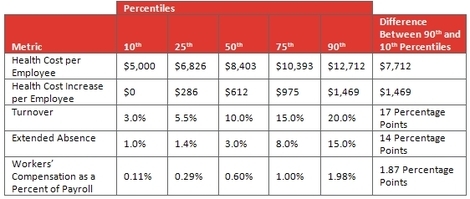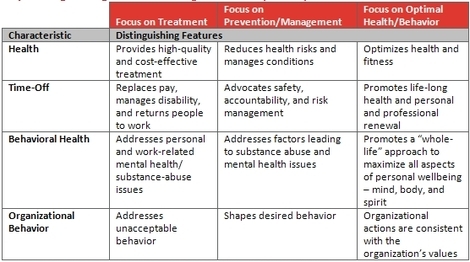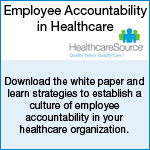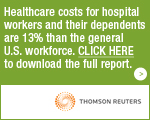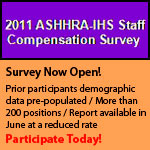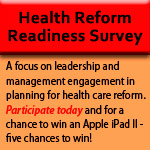| April 12, 2011 | Printer Friendly Version | Advertise | Join ASHHRA | ||

|
PRESIDENT'S MESSAGE
Hello ASHHRA Members, As promised in last month's letter, I wanted to share the goals your ASHHRA Board is working very diligently on for this year. Each of the goals are aligned to our three year strategic plan. I am extremely pleased with the focus and effort to date and I am highly confident we will have a very successful year. Board members Grace Moffitt, Maureen O'Keeffe, and I are exploring the whole idea of certification for health care human resources professionals. Since our business segment is going to explode with the advance of baby boomers needing health care services, we are exploring the idea of a valued product, an educational component, and a potential partner in this quest. This is very strategic and we are currently in the research phase. Board members Karmen Reid and Tom McCawley are working on a laundry list of important actions to improve service to the chapters/regions including trying to increase chapter membership, assisting chapters with mentorship programs, and monthly e-mails to chapter leaders. For the regions, goals have been established to include more information on newsletters, regular calls with chapter presidents, and providing at least one advocacy representative at each state conference. Board member Paul Morlock and President-elect Irma Pye have developed a three tiered approach to establishing an exciting and extremely valuable new program for you. They are currently working on Tier One. We will tell you more about it in the coming months, so stay tuned.
Board members Marit Brock and John Ostrom have defined very specific goals in increasing Non-Hospital membership by three percent, which is 20 additional members for this year. They are planning to reach out to several non-hospital professional groups for partnership opportunities and will develop a Non-Hospital Track of presentations for our annual conference and target market potential attendees. They will also ramp up the ListServ to include all current non-hospital members and propose to update our marketing road show presentation to market the non-hospital segment. Board members Joe Miccuci and Paul Morlock have engaged the area of technology and have identified and reviewed six areas for potential improvement: optimization of technology, and proposed upgrades including online purchasing, launching e-books, a member spotlight, and establishing blogs, just to mention a few. Board member Nicole Morin-Scribner and Immediate Past President Jeff Payne have begun work on the issue of wellness and establishing a culture of health in our organizations and providing the tools to our constituency for doing so. This effort will include communicating best practices and presenting findings, but most importantly providing you with the tools you need in your organization. We have also identified opportunities for our organization to become more proactive in partnering with other Professional Membership Groups (PMG) within the AHA to include leadership in policy and advocacy, education and sponsorships, educational presentations in our field of health care human resources, and collaboration on important and pertinent initiatives in our field. ASHHRA Executive Director Stephanie Drake, CEO Board Member Melissa Kinnaird, and I are working on these initiatives with the entire Board of Directors. Have a great month and I will continue to provide status on a quarterly basis. Robert Walters, SPHR ASHHRA NEWS
LEGAL
WORKFORCE
COMPENSATION
GENERAL HR
BENEFITS
PHYSICIANS
MANAGEMENT & LEADERSHIP
ASHHRA NEWS
LEGAL
WORKFORCE
Hospitals willing to engage community-based organizations have a tremendous opportunity to maximize the impact of workforce development goals. It’s a concept that has strong and active collaborative stakeholders in Chicago united around a common goal: helping entry-level health care employees gain the skills and education needed to advance. The result is a win-win situation: engaged employees are funneled into high-demand careers, letting the employer fortify pipelines while attracting the best new entry-level talent to fill newly vacated positions. The project’s roots took hold at a community hospital in the city’s near Southwest Side. In 2009, Saint Anthony Hospital introduced the innovative School at Work® (SAW) program, and successfully graduated its first class of 18 students last August. SAW is a technology-based system created by Catalyst Learning Company, based in Louisville, KY. It combines coach-based mentoring with online health care-specific coursework, DVDs, and career development activities. SAW is unique in how it addresses the needs of entry-level adult-learners. Employees attended classes during the workday and received coaching on life/time management and career planning while completing the health care-specific curriculum. Pamela Jones, director of Workforce Development at Saint Anthony Hospital was the hospital’s lead individual for implementing SAW. Jones, who has 15 years of experience developing and managing employment training programs throughout Chicago, decided to take the life management content to a new level and identified community partners to help students address barriers. Additional services were provided at the worksite, either during or immediately after SAW classes. With full support by Saint Anthony Hospital’s leadership, Guy A. Medaglia, president and chief executive officer, Jones created and executed a plan to bring educational opportunities to Saint Anthony Hospital’s employees; furthermore, she expanded the model to create a "one-stop shop" within Saint Antony that would give workers greatly expanded education and services to pursue post-SAW studies. "We believe in investing in our community and our employees. By providing them with no-cost educational opportunities through SAW, we are helping them to broaden their skill sets. Also, their quality of life will be improved because they’ll be better able to support their families, enhancing the well-being of the community overall. Ultimately, we plan to offer this program to many more of our employees and open it for the entire community," said Medaglia. The support and engagement showed in the astonishing results. All of Saint Anthony’s original participants enrolled in community college after completing the program. "All of my graduates worked really hard to achieve their goal," said Jones. "Their commitment and motivation fueled by the support of their managers and supervisors here at work is impressive. I can see they are already on the right path as they celebrate and make plans to continue with their studies." The success caught the attention of city officials, which led to an evaluation to determine whether or not the model could be expanded throughout the city. "The model appealed to the Metropolitan Chicago Healthcare Council (MCHC) and (Chicago’s) Department of Family and Support Services (DFSS). Once they saw the outcomes and understood how the program was designed to provide a holistic solution, it provided an opportunity for our local association and the city to be part of something big," said Jones. As a result, Saint Anthony and 12 other hospitals were awarded funds from the DFSS. In addition to the MCHC, community partners included the Eleanor and Steans Family Foundations (two organizations that provided funding to Saint Anthony for the 2009 SAW pilot), Heartland Human Care Services, Instituto Del Progreso, Central States SER, City Colleges of Chicago, Chicago Low-Income Housing Trust Fund, and the Chicago Economic Development Law Project. The city’s top brass also took an interest. To address the need for an increasingly skilled workforce in Chicago’s health care industry, Chicago Mayor Richard M. Daley announced the launch of the project and designated Saint Anthony Hospital as the mentor organization. One participating organization was Mercy Hospital and Medical Center. Nancy Hill-Davis, vice president of Human Resources/Risk Management was familiar with SAW, having first learned of it while attending the ASHHRA Conference in 2006. Mercy had long provided a range of opportunities for professional and clinical staff, but other than general customer service training, the organization lacked a systematic approach to helping frontline workers strengthen basic skills and enter workforce pipelines. Though Hill-Davis was initially excited at the prospect of filling the gap, a lack of resources prevented her from doing so. Finally, in late 2009, the organization was in a position to launch SAW. Coincidentally, it was during the planning phase that she learned about the funding opportunity. Mercy moved quickly to join the growing collaborative of Chicago hospitals; in February 2010, 18 Mercy employees joined the citywide cohort. Like at Saint Anthony, Mercy’s participants are achieving their goals. An example is Registrar Monica Caldera, who is enrolled in the nursing program at Malcolm X Community College. Caldera credits the support of her supervisors and Mercy leadership for her success. Genella Harper, supervisor of Sterile Processing, had two employees participate, which motivated her to attend the October graduation ceremony. "The speech (my employee) Gerald gave inspired another one of my techs to enroll in the next session. I support this decision! This experience has changed my employees; they now pay more attention to the detail on their trays, which impacts the patients, doctors, and nurses." Hill-Davis echoes that the supervisors, along with Mercy’s executive leadership, gave strong support to the students. "First off, I was surprised at how willing the supervisors were to let employees do this during the work time; there were absolutely no complaints. Upper-level management also got involved and has made recommendations for future participants. This investment pays off. We are committed to having the best and brightest here, and the effect trickles down to impact high-quality patient care and service." At Resurrection Medical Center on Chicago’s North Side, 10 of the 11 participants enrolled in continuing education immediately after completion. Lizette Wheeler is one such employee. Wheeler, a security officer who has been employed at Resurrection for four years, is also working toward a nursing degree at Malcolm X Community College. Like Caldera at Mercy, Wheeler credits the support of hospital leadership with helping her stay focused. "I now have nurse mentors who are helping me with homework, and one doctor who saw my books has also taken an interest in encouraging me," she said. For the second year in a row, all Saint Anthony’s participants have enrolled in community college. Jazette L. Moffitt is a graduate of the 2009 pilot who has since gone on to enroll in the business program at Wright College. Moffitt addressed graduates at neighboring hospital Sinai Health System in October. The medical claims analyst told the audience that, "This experience caused me to think on a larger scale about what I want to do for my children and my employer. It helped me know that I can achieve a goal if I plan and prepare." A recent MCHC survey of 2010 SAW graduates indicated that 96 percent of participants have more motivation at work and 92 percent have increased interest in enrolling in continuing education. "Results of the survey not only make the case for offering SAW to hospital frontline employees, but also to build on the momentum created by the program to promote career and educational advancement opportunities," said Mary Pat Olson, director of MCHC’s Health Care Workforce Institute. MCHC is now working with its member hospitals and stakeholders at DFSS, Saint Anthony Hospital, Catalyst Learning Company, Wilbur Wright College, and Central States SER to develop a strategy to transition all interested SAW graduates into the community college system. In addition, MCHC is promoting resources and services from community partners that would give SAW completers and other eligible employees the opportunity to receive financial counseling and attend community college classes at the worksite. The model shows sustainability; planning for year two of the Chicago SAW project is underway. MCHC plans to incorporate key components of the further academic success action plan. Amy Santacaterina, deputy commissioner of Workforce Services for DFSS, says that, "We are very pleased with the success of Chicago School at Work and think this is a quality curriculum. We are excited about continuing it in 2011-- if we can get more people to advance, that will really help our hospital partners grow their own and help fulfill a need with employees who have proven themselves to be dedicated and hardworking. Plus, it gets people on a career path to sustain their families and earn good wages." At Saint Anthony Hospital, where it all originated, employees continue their path to educational success and career advancement as a result of the SAW program. "Our objective is to ensure that our employees grow in every way possible. Our mission as a community hospital is to care for all, which includes providing opportunities for our associates so they can reach their full potential for themselves and their families within our community. Thanks to our strong partnership with Catalyst Learning, we are helping them achieve their goals," concluded president and CEO Medaglia. COMPENSATION
GENERAL HR
Human resources professionals often do not have time to pontificate on the role of ethics in business and health care. Milton Friedman, the legendary economist, was quoted as saying, "The business of business is business (1970)." Others would argue that ethics do matter. Ethical scandals have plagued health care companies like Columbia/HCA, a featured case study in Business Ethics: Ethical Decision Making and Cases (Ferrell et al., 2008), a leading business ethics textbook. Ethics in human resources in health care is not solely academic; it is a matter of strategic and reputational importance to any senior leadership team and board. Staying Out of the Headlines... and Off YouTube It's More Than Staying Out of the Headlines... and Off YouTube
Are these ethical issues the domain of the ethics committee and/or human resources? The ethics committees in most hospitals are to be commended for addressing those issues that fall under clinical ethics but far too many do not focus upon organizational ethics. In fact, it has been argued that there is a risk for hospital ethics committees to address business ethical issues because of being co-opted by institutional values (Boyle, 1990). In short, it is akin to "the fox guarding the hen house." Winstanley and Woodall (2000) argue that human resources management holds the moral stewardship of organizations. Furthermore, it has been argued that human resources management is a key part of business ethics (Trevino & Nelson, 2010). This means more than ensuring legal and regulatory compliance. It is well known that what is legal may or may not be ethical (Trevino & Nelson, 2011). For example, it is legal to offer executives incentive bonuses while at the same time freezing pay for frontline workers and even laying off workers in certain departments. However, this may not be ethical. Ethical Decision Making: Organizational, Group, and Individual Perspectives
An example of how important it is to clarify who is making an ethical decision involves billing and collecting delinquent accounts. Generally, finance is responsible for accounts receivable (A/R). Given the Provena Covenant Medical Center legal case in which the state disqualified the property tax exemption of Provena for aggressive billing and collection policies and practices (Salinsky, 2007), the question arises as to whether HR should be involved by weighing in on decisions regarding the outsourcing of revenue cycle management services, the training of A/R staff of the ethical issues involved in collecting and even training in emotional intelligence to demonstrate caring and compassion even when collecting a delinquent account. The Provena case shows the role of ethics in the community. According to Trevino & Nelson (2011), the community is a stakeholder. In health care, the community has taken on special importance with the introduction of the Form 990 as well as Schedule H and the resurgence of the community benefit standard. Organizational Level In short, human resources is vital to the cultivation and maintenance of an ethical organizational culture through the design and delivery of formal systems such as selection systems and performance management systems (Trevino & Nelson, 2011). Do your selection, orientation, training, performance management, and reward systems include values and ethical expectations? Group/Team Level Another illustration is the increase in pay-for-performance (P4P) programs for physicians and other direct-care providers. Wharam and colleagues (2009) have identified eight potential ethical problems with P4P programs. These eight ethical problems sit at the interface among clinical decisions, population health decisions and human resources management decisions. Is HR invited to the table to participate in these decisions which have an ethical implication or does HR have to invite itself to the table because of its unique role, knowledge and skills? Individual Level At all three levels, an ethical decision-making framework is required for organizations, groups, and individuals to methodically work through prior to formulating a decision. This will not always result in the optimal decision. There will still be ethical lapses. But if deliberation has occurred, then this can prevent many ethical lapses. An ethical decision-making model (Markula Center, 2011) is highlighted below for the use of HR professionals and those that they interact with both inside and outside the organization.
A related ethical decision-making tool for HR professionals is to differentiate distributive justice from procedural justice. Distributive justice answers the question, "Was the outcome fair?" And procedural justice answers the question, "Was the way in which the outcome was decided fair?" HR professionals must attend to both and aim for the following response to both questions: Yes. Recommendations
References BENEFITS
It's no secret that budgets are lean in this economy. Employers estimate an average increase in health care costs of 8.9 percent for 2011*, which means employees may feel the pinch with higher out-of-pocket costs. Since benefits are linked to attracting, retaining and motivating top-performing employees, HR professionals in the health care industry are continually faced with the challenge of identifying ways to make their benefits packages more attractive without increasing costs. To help offset rising health care costs and continue to provide an attractive benefits package, a growing number of health care employers are turning to voluntary auto and home insurance benefits, and for good reason. Here are five compelling reasons why hospitals and health care systems are leveraging the advantages of voluntary auto and home insurance benefits plans.
When you can strengthen benefits programs without affecting your budget, adding voluntary auto and home insurance programs seems to make good business sense. After all, you really can't go wrong helping employees save money on necessary household expenses, especially when there's no impact on your budget and workload. Wayne Tryon is an ASHHRA member and the business development director for the Travelers Affinity Auto & Home Program specializing in the health care industry. He has primary accountability for working with hospitals and health care networks to develop and execute voluntary auto and home insurance benefits. He has more than 30 years of experience in the insurance industry and has achieved the designations of Chartered Property Casualty Underwriter (CPCU) and Chartered Life Underwriter (CLU). Travelers is also an Associate Member of AHA. To learn more about offering voluntary auto and home insurance benefits, visit www.travelers.com/affinity and contact Wayne Tryon at 800.328.2189, ext. 79831. *National Business Group on Health Health care organizations, just like most other employers in the United States, are facing an unprecedented tsunami of poor employee health. Chronic health problems, increased absence and disability, turnover of key talent and loss of productivity are undermining many hospitals' ability to properly execute their business strategy. Recognizing these factors, some forward-thinking HR leaders and administrators are taking steps to address both the health and the health care needs of their employees. These health-focused health care providers are partnering with their employees to create and implement preventive health care solutions that aim to optimize their health and behaviors, not just eliminate risks. What Outcomes Can Hospitals and Health Care Systems Expect? The study found significant variance in each of the outcome metrics reported – health cost per employee, health cost increase per employee, turnover, unscheduled absence, extended absence, and workers' compensation cost as a percentage of payroll. As the table below shows, the 90th percentile is always more than double the 10th percentile (the level at which 10 percent of respondents reported a lower outcome). This relationship is also consistent even after adjusting for industry and demographics. Differences in Outcome Metrics by Percentiles of Respondents*
* For each metric, the percentiles of respondents reflect the lowest to highest dollar amounts or percentages. To better understand the organizational drivers for this variance, Sibson developed a Healthy Enterprise Index, which rates organizations from zero to 100 percent, according to how well they partner with their employees on health initiatives. The average Healthy Enterprise Index score is 57 percent. Although not every health care organization will aim for a Healthy Enterprise Index of 100 percent, its leaders may want to determine their index and, if it is low, develop strategies to improve it. Sibson has found that a higher Healthy Enterprise Index is associated with lower health care costs. On average, a 10 percentage-point increase in the index equates to a $160 reduction in health care cost per participant. An organization that has an average of 1.5 dependents for each employee could experience a reduction in annual health care costs of $400 per employee by increasing its index by 10 percentage points. Participants in the top quartile of the Healthy Enterprise Index achieve better outcomes across the board, as shown in the following table. Comparison of Average Adjusted* Outcome Metrics for the Top Quartile Compared to All Others
* Sibson adjusted each outcome metric for various factors, such as industry and demographic (i.e., age and average family size). For information about which adjustments were applied to each metric, refer to the online supplement to this report that discusses the study methodology, which is available on the following page of Sibson's Web site: http://www.sibson.com/publications/surveysandstudies/HESsupp2.pdf The ROI of becoming a healthy hospital is potentially considerable. For example, a recent meta study (a study of studies) conducted by Harvard University concluded that the return can be 3.27:1 on medical costs and 2.73:1 on absence and related costs. The programs that were the subjects of the reviewed studies generally were crafted carefully with the intent of measuring an outcome. This suggests that hospitals need to design their healthy hospital initiatives carefully to ensure they, in time, will produce a healthy ROI. What Steps Should Health Care Organizations Take to Become Healthy?
In addition to the cost savings associated with being a healthy hospital, there may be productivity gains to the extent that healthy employees are more satisfied with their jobs and more engaged in their work than are unhealthy employees. Trying to become a healthy hospital right out of the blocks can be a daunting task that is outside the scope of most hospitals and health care organizations. A more realistic approach is to start by defining a strategy that clearly aligns with and supports the business strategy. Health care organizations can then begin by making investments that optimize success within the current culture. Many hospitals start promoting health and productivity by repackaging the programs and services they already have in place to support the strategy. They then add resources (e.g., health-risk assessments and screenings) to help employees and their families understand their risks and conditions and to better manage them through behavior modification (e.g., using health coaches, education, and other tools). So, How Healthy Is Your Organization?
A number of factors differentiate the three stages of a healthy hospital. For example, where a hospital in the first stage will primarily be reactive in treating conditions and dealing with unacceptable behavior, a hospital in the second stage will focus on managing risks and conditions by shaping behavior. A hospital in the third stage, however, will focus on optimizing health and behavior by maintaining a healthy culture that is evident at every level. In addition to this strategic orientation, each stage of maturity is characterized by its approach to addressing the various elements of its programs/initiatives, such as health plans, time-off programs, workplace support, behavioral health programs, communications, organizational behavior, and measurement and metrics. See the table below, for a sample of key distinguishing features. Key Distinguishing Features Along the Healthy Enterprise Continuum
Source: Sibson Consulting Conclusion Steven F. Cyboran is a vice president and consulting actuary in the Chicago office of Sibson Consulting. He leads Sibson's Healthy Enterprise Initiative and has been actively involved in a variety of projects focusing on cultural transformation. He can be reached at 312.984.8558 or scyboran@sibson.com. Glenn M. Alonzo is a senior vice president and national hospital and health care market leader in the Hartford office of Sibson Consulting. He can be reached at 860.678.3013 or galonzo@sibson.com. PHYSICIANS
MANAGEMENT & LEADERSHIP
Many people remember seeing encouraging comments written on the top of their elementary school homework assignments. The friendly green ink and accompanying colorful stickers always seemed to bring a smile to an ordinary moment during the day. Teachers make these comments to build their students' self-esteem, and to show their hard work is noticed and appreciated. In turn, children take these words to heart, soaking up the praise and reveling in a sense of accomplishment. It turns out an individual's need to be recognized does not change all that much as he or she gets older. According to a recent study conducted by HR Solutions Inc., recognition is the key driver of Employee Engagement1. Some might find it surprising that recognition surpasses many other important motivational factors, such as adequate training, relationships with co-workers and career growth. These results illuminate that even as adults, people still want to feel appreciated for a job well done. Tapping into this engagement driver seems simple enough, yet research has shown that many organizations' efforts have been ineffective in this regard. Only 59 percent of employees say their supervisor lets employees know when they have done a good job. These findings reveal that many employees do not feel as though their manager acknowledges their accomplishments. Surely, more than 59 percent of managers appreciate when their employees have done a good job, so there must be a common disconnect somewhere in the process of showing recognition. It is important for managers to consider their employees' perceptions of receiving recognition, and how this can differ from their own perception of giving recognition. Although managers may think they are frequently recognizing employees, many employees may not feel the same way. According to a recent study by Michael C. Fina, Millennials, generally characterized as people born between 1980 and 2000, like to be recognized seven times each day. To some tenured employees, this may come across as an indulgent and unrealistic expectation. While that might have been true many years ago, American culture has shifted dramatically over the years, causing workforce culture to change as well. For instance, Millennials are famous for growing up in an era where 13th place ribbons actually exist. To attract and engage this new generation, company recognition efforts must keep up with the times. Although recognizing employees seems fairly straightforward, there is more structure and planning that goes into a successful recognition program than many people might realize. It is great to tell someone they have done a good job, however, it makes a difference what they are recognized for, how they are recognized and how often they are recognized. Creating a program that appropriately caters to all of these aspects can be challenging. To help simplify this process, HR Solutions has compiled a list of 10 best practices for developing an organizational culture of recognition: 1) Define what should be recognized 2) Be sincere 3) Recognize in public and in private Providing private recognition can also be very effective in showing employees they are appreciated. Private recognition is easier for managers to give more frequently and it is as simple as a quick "on-the-spot" verbal thank you. Whether it is an email, voicemail, hand-written note, or just stopping by in person, letting an employee know they have done a good job goes a long way and only takes a few moments. 4) Balance criticism 5) When in doubt, ask! 6) Equal does not necessarily mean fair 7) Do not overdo it 8) Appropriate rewards 9) Educate employees on your efforts A best practice for involving employees is to ask for feedback on new initiatives they would like to see. When management is aware of employee opinion, it is much easier to make the changes employees desire. Any changes that are made as a result of employee feedback should be clearly communicated to staff members. A hospital newsletter or bulletin can be a great vehicle for educating employees. 10) Encourage employees to recognize one another A strong recognition program can be the difference-maker in an engaged workforce. Although employees no longer need smiley-face stickers on returned assignments, they do need recognition for a job well done. Luckily, it is easy for managers to begin increasing recognition immediately. A great way to start a new initiative is by setting a calendar reminder to recognize one employee each day and increasing this number over time. When providing frequent recognition becomes second-nature, employee engagement should increase as well, creating a workplace culture headed toward organizational success. 1HR Solutions' International Normative Database is comprised of over 3.3 million survey respondents from 2,400 organizations across various industries. About HR Solutions, Inc.: Noted for its comprehensive research and actionable data, HR Solutions, Inc. is an International Human Capital Management Consulting Firm located in Chicago, IL, specializing in Employee Engagement and Exit Survey design, implementation, and results. HR Solutions is the exclusive endorsed provider of The American Hospital Association (AHA) for Employee, Exit, and Physician Surveys. For more information, please visit www.hrsolutionsinc.com. |
ASHHRA Mission To advance the human side of health care, the American Society for Healthcare Human Resources Administration (ASHHRA) leads the way for highly effective, valued, and credible leaders. Contact: ASHHRA FOLLOW US ON |
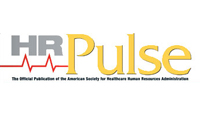
|

|
 |
155 North Wacker, Suite 400 Chicago, IL 60606 Ph.: 312.422.3720 Fax: 312.422.4577 E-mail: ashhra@aha.org Website: www.ashhra.org |




